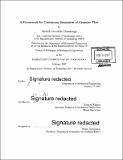A framework for continuum simulation of granular flow
Author(s)
Dunatunga, Sachith Anurudde
DownloadFull printable version (16.91Mb)
Other Contributors
Massachusetts Institute of Technology. Department of Mechanical Engineering.
Advisor
Kenneth Kamrin.
Terms of use
Metadata
Show full item recordAbstract
Granular materials have eluded continuum modeling attempts for centuries. A significant chunk of the complexity lies in the trans-phase behavior of granular media; while the material has a yield stress and can therefore act as a solid body, grains may also flow quickly much like a liquid. At low pressures and high velocities, the grains may even become disconnected from each other, resulting in a gas-like state where the only stresses are essentially due to occasional collisions between grains. Moreover, all three states are commonly found simultaneously in many industrial and natural processes, and individual grains may switch between these phases readily. A further complication is that typically the grain size is large compared to the geometries in which we are interested; these size effects can lead to mispredictions when purely local models (without an intrinsic length scale) are used. Due to these complexities, a highly favored technique is the discrete element method, which tracks each grain individually and updates the forces and displacements when grains contact each other. While extremely accurate, discrete methods require incredible amounts of computational power, severely restricting the sizes of problems that can be simulated. Continuum techniques can potentially scale better, as individual grain-grain interactions are no longer tracked, but require a constitutive model. Recent continuum models, such as in Jop, Forterre, and Pouliquen (2006) and Kamrin and Koval (2012) show promise in capturing many observed phenomena, yet current numerical techniques limit the applicability of these models due to computational or numerical issues. In this thesis, we explore a continuum framework for simulation of granular materials in the context of the material point method, which allows us to test these material models further than many existing continuum techniques and pave the way for efficient simulation of large-scale processes involving granular media.
Description
Thesis: Ph. D., Massachusetts Institute of Technology, Department of Mechanical Engineering, 2017. Cataloged from PDF version of thesis. Includes bibliographical references (pages 119-124).
Date issued
2017Department
Massachusetts Institute of Technology. Department of Mechanical EngineeringPublisher
Massachusetts Institute of Technology
Keywords
Mechanical Engineering.